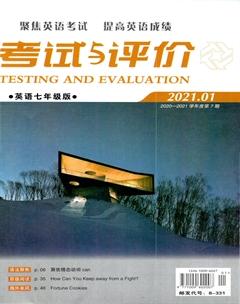Unit 1词语和句型考点归纳
徐敏娜

【词语精讲】
1. play
play 用作动词,意为“打;踢”,后面加球类名词时,不需要加冠词。如:
play soccer踢足球;play ping-pong 打乒乓球;play tennis打网球
【拓展】 作“弹拨;吹奏”解时,后面加乐器类名词,表示演奏某种乐器,需加上定冠词the。如:
play the guitar 弹吉他;play the violin 拉小提琴;play the piano 弹钢琴
2. write
write意为“写作;写字”。既可用作及物动词,也可以用作不及物动词。如:
Im writing a letter to my grandfather. 我正在给我爷爷写信。
【拓展】常用搭配:write down 写下,记下; write to sb. 写信给某人; write back 回信。
3. speak
speak既可作及物动词,也可作不及物动词。
(1) 当speak作及物动词时,意为“讲话;发言”。如:
The baby is learning to speak. 这个孩子正在学说话。
(2) 当speak作不及物动词时,可构成词组speak to sb. 意为“和……讲话,谈话”。如:
Can I speak to Mr. Zhang? 我能和张先生讲话吗?
She is speaking to her teacher. 她正在跟她的老师说话。
(3) speak后面可以直接接语言。如:
She speaks English quite well. 她英语说得很好。
Lucy can speak English and a little Chinese. 露西会说英语和一点汉语。
辨析:speak, say, talk与tell
(1) speak意为“说话;发言;演讲;说(某种语言)”等,强调说话能力。如:
I can speak a little English. 我会说一点英语。
(2) say意为“说;讲”,强调说的具体内容,后跟直接引语或间接引语。如:
Lisa says shes ten years old this year. 丽萨说她今年十岁了。
(3) talk意为“说话;谈话”,强调与某人交谈。如:
I want to talk to you. 我有话想要跟你说。
(4) tell意为“告诉;讲述”,其后可接双宾语,也可接story, lie等名詞,还可以接句子。如:
Please tell me what happened. 请告诉我发生了什么事。
Please tell us a story, OK? 请给我们讲个故事,好吗?
4. also
also用作副词,意思为“也;而且”,通常置于行为动词之前,连系动词、助动词、情态动词之后。如:
John is also a member of basketball team. 约翰也是篮球队的一员。
I play basketball and I also play soccer. 我打篮球,也踢足球。
辨析: also & too
also和too均可表示“也”,用于肯定句和疑问句中,但also常置于句中;too常置于句末,前面常用逗号隔开与句子的其他成分。如:
Can he also swim? 他也会游泳吗?
He will also go abroad. 他也准备出国。
I will help you, too. 我也会帮助你的。
5. people
people是集合名词,意为“人;人们”,以单数形式表示复数概念。如:
Who are these people? 这些人是谁?
Nowadays people like to keep pets. 如今人们喜欢养宠物。
【拓展】 people还可以作“种族;民族”解,此时有单复数之分。如:
There are fifty-six peoples in China. 中国有五十六个民族。
6. teach
teach用作动词,意为“教;讲授”,其后常接双宾语或复合宾语。如:
Mr. Wang teaches us English. 王老师教我们英语。
Who taught you to ride a bicycle? 谁教你骑自行车的?
【拓展】 常用搭配:teach sb. / sth. 教某人/某事;teach sb. to do sth. 教某人做某事;teach oneself自学;teach sb. a lesson给某人一个教训
7. show
show既可以用作动词,也可以用作名词,用作动词时,意为“展示,出示;给……看”等,其后通常接双宾语,即“show sb. sth.”,意为“给某人看某物”; show用作名词时,意为“演出;节目;展览”等。如:
Show me the pictures, please. 请给我看那张图片。
The fashion show is about to start. 时装秀马上要开始了。
8. join
join用作动词,意为“参加;加入”,指加入某个团体、组织、人群等,并成为其中的一员。如:
Mike wants to join the swimming club. 迈克想加入游泳俱乐部。
He joins us for lunch. 他和我们一起吃午餐。
辨析: join, join in与take part in
【短语串串】
1. play chess 下国际象棋 2. speak English 说英语 3. play the guitar 弹吉他 4. join the English / art / music / chess / swimming / story telling club加入英语/美术/音乐/国际象棋/游泳/讲故事俱乐部/社团 5. play games 玩游戏 6. tell / write stories讲/写故事7. school show 学校表演 8. talk to...和……
9. English-speaking students 说英语的学生
10. old peoples home 养老院 11. be free 有空的 12. be good with... 和……相处得好;对……有办法 13. make friends交朋友 14. on the weekend / on wekends (在)周末 15. music festival 音乐节
【难句在线】
You are very good at telling stories. 你很擅长讲故事。
be good at sth. / doing sth. 表示“擅长于……”,后接名词或动名词形式。与 do well in 可转换使用。如:
Scott is good at playing the piano. 斯科特擅长弹钢琴。
Rick is good at maths. = Rick does well in math. 里克数学学得很好。

